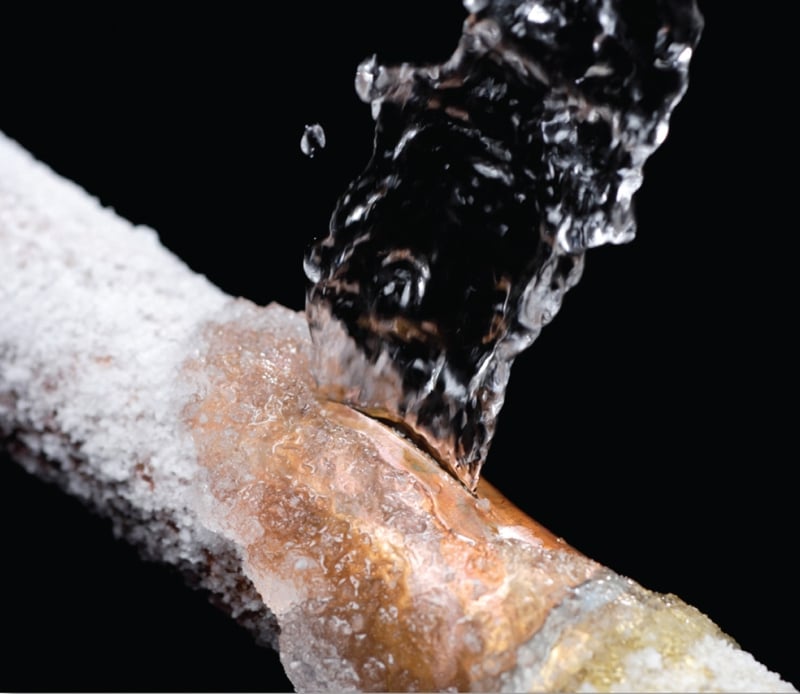
Everyone knows that a can of soda will explode if left in the freezer, and this is also what happens to pipes when they freeze. Frozen pipes can be very costly to repair, and can also result in damages to the structure of your home and your possessions. Preventing frozen pipes can be one of the most important chores you do to protect your home, and Warner Service has put together this guide to help keep yours safe this winter.
Why Pipes Burst
You would think that pipes burst at the spot where they are frozen, but actually, it is not the expansion of ice against the pipe that causes bursting. Freezing and expansion inside the pipe causes water pressure to increase between the frozen areas and a closed faucet at the end. It's this increase in water pressure that leads to pipe failure and bursts. In fact, pipes rarely burst where ice has formed inside them. Pipes also rarely burst near the water source, because usually the water is able to retreat back and relieve pressure.
Plumbing System Factors
Homes in the Frederick, MD area are usually built with the water pipes located on the inside of the building insulation, which protects the pipes from winter weather. However, extremely cold weather and holes in a building can allow a flow of cold air to come into contact with pipes can lead to freezing and bursting. Pipes in attics, crawl spaces and outside walls are all vulnerable to freezing, especially if there are cracks or openings that allow cold, outside air to flow across the pipes. Holes in an outside wall where cables enter can also provide access for cold air to reach pipes. The size of pipes and their composition (usually copper or PVC) have some bearing on how fast ice forms, but they are relatively minor factors in pipe bursting compared with the absence of heat, pipe insulation and exposure to a flow of subfreezing air.
Preparing for Frozen Pipes
Water freezes when heat in the water is transferred through the pipes to subfreezing air. The best way to keep water in pipes from freezing is to slow or stop this transfer of heat. Ideally, it is best not to expose water pipes to subfreezing temperatures by placing them only in heated spaces and keeping them out of attics, crawl spaces, and other vulnerable outside walls. In new construction, proper placement can be designed into the building.
In existing houses, a plumber may be able to move at-risk pipes to protected areas, but this may not be a practical solution because of cost. If the latter is the case, vulnerable pipes that are accessible should be fitted with insulation sleeves or wrapping, which slow the heat transfer process. It is important not to leave gaps that expose the pipe to cold air. Hardware stores and home centers carry the necessary materials, usually in foam rubber or fiberglass sleeves. Better yet, plumbing supply stores and insulation dealers carry pipe sleeves that feature extra-thick insulation, as much as one or two inches thick. The added protection is worth the extra cost.
Cracks and holes in outside walls and foundations near water pipes should be sealed with caulking to keep cold wind away from the pipes. Kitchen and bathroom cabinets can keep warm inside air from reaching pipes under sinks and in adjacent outside walls. It's a good idea to keep cabinet doors under your sink open during cold spells to let the warm air circulate around the pipes.
Letting the Water Run
Letting a faucet drip during extreme cold weather can prevent a pipe from bursting. It's not that a small flow of water prevents freezing; this helps, but water can freeze even with a slow flow. Rather, opening a faucet will provide relief from the excessive pressure that builds between the faucet and the ice blockage when freezing occurs. If there is no excessive water pressure, there is no burst pipe, even if the water inside the pipe freezes.
A dripping faucet wastes some water, so only pipes vulnerable to freezing (ones that run through an unheated or unprotected space) should be left with the water flowing. The drip can be very slight. Even the slowest drip at normal pressure will provide pressure relief when needed. Where both hot and cold lines serve a spigot, make sure each one contributes to the drip, since both are subjected to freezing. If the dripping stops, leave the faucet(s) open, since a pipe may have frozen and will still need pressure relief.
If You Suspect a Frozen Pipe
If you open a faucet and no water comes out, don't take any chances: call a plumber right away. If a water pipe bursts, turn off the water at the main shut-off valve (usually at the water meter or where the main line enters your house) Then, leave the faucet(s) open until repairs are completed. Don't try to thaw a frozen pipe with an open flame; as this will damage the pipe and may even start a building fire. You might be able to thaw a pipe with a hand-held hair dryer, but proceed with caution (especially if the pipe is made of PVC). Slowly apply heat, starting close to the faucet end of the pipe, with the faucet open and working toward the coldest section.
If you are leaving on a trip this winter, be sure to check out our Snowbird's Guide to Frozen Pipes to protect your home while you're away.
Warner Service knows that maintaining your plumbing and preparing for pipe bursts can be one of the best ways to keep your home safe this winter. If you need more information about keeping your plumbing safe, contact Warner Service today to have a qualified plumber examine your plumbing system.
